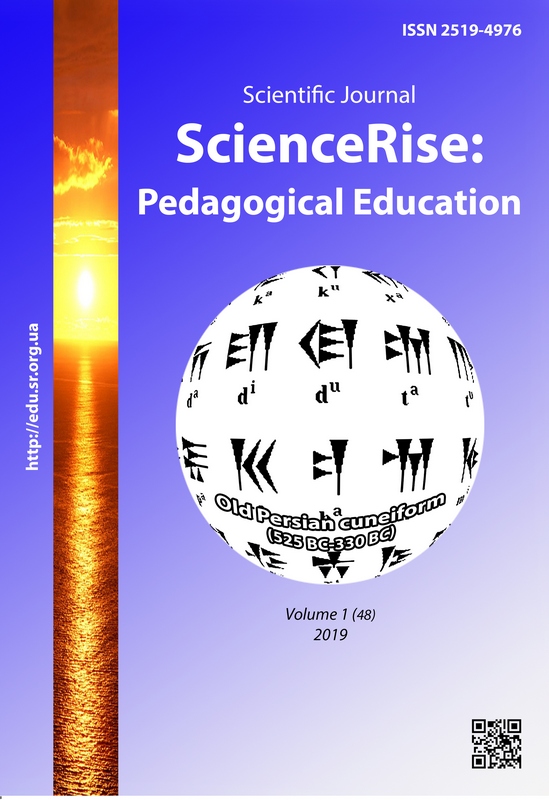Features of professional-pedagogical training of teachers of technical higher schools of the ussr in the 1940s-60s.
DOI:
https://doi.org/10.15587/2519-4984.2019.155353Keywords:
technical higher educational establishment, professorial teaching staff, pedagogical practice, postgraduate studyAbstract
The article is devoted to the study of the features of vocational and pedagogical training of teachers for higher technical educational institutions during 1940s-60s. The main objectives of the article are to determine the factors that influenced the development of a higher technical school during the specified period; identification of the main tendencies of the process of providing technical universities with scientific and pedagogical workers; and most importantly - an analysis of the pedagogical component of teaching staff training for higher technical schools of the designated time. The sources of the research were the numerous cases of the funds of the State Archives of the Dnipropetrovsk region (DADO) concerning the post-graduate course of technical universities of Dnipropetrovsk during 1940s-1960s. The results of the study confirmed the widespread thesis about poor provision of the educational process in the high school of the 1940s-60s by curricular staff with academic degrees. It is important to note one more tendency of the development of the high technical school of the UkrSSR during 1940s-1960s - the formation of a hierarchical system of interdependencies between the structural units of a separate institution of higher education and state authorities of different levels. No decision taken in the walls of higher education, did not pass the attention of the ministry or the corresponding agency of the republican, and often even the union level. Such rigorous subordination of the activity of educational institutions in the field of personnel policy (with the exception of the assignment of the academic title of lecturer) once again proved total control in the Soviet state in all spheres of life, and the field of education and science was no exception. All scientific and scientific-pedagogical workers were subjected to thorough accounting and annual reporting on their activities (as well as nationality, party membership, marital status, etc.). As the process of replenishment of the teaching staff by the new members in general was going very slowly, the pedagogical component of the mentioned process was also organized very formally. The archival sources indicate a lack of attention to the organization of postgraduate pedagogical practice, their participation in the work of the departments, and the involvement of students in scientific and technical circles
References
- Boehrer, J., Sarkisian, E. (1985). The teaching assistant’s point of view. New Directions for Teaching and Learning, 22, 7–20. doi: http://doi.org/10.1002/tl.37219852203
- Bourner, T., France, L., Atkinson, A. (2003) Preparing and developing university teachers: an empirical study. Higher Education Review, 35 (3), 23–41.
- O’Connor, K. M., Wisdom, J. (2014). The preparation of university teachers internationally. Available at: http://icedonline.net/iced-members-area/the-preparation-of-university-teachers-internationally/
- Galkin, K. T. (1958). Higher education and training of scientific personnel in the USSR. Moscow: Soviet science, 175.
- Sidorchuk, T. G. (1998). Preparation of scientific and scientific-pedagogical personnel through postgraduate study in Ukraine (1920–1970s). Zaporizhzhia, 20.
- Yukhno, O. I. (2016) The activities of polytechnic universities in the context of the development of higher technical education in Ukraine (second half of XX century). Sumy, 20.
- Reghelo, I. Yu. (2011). Trends in the development of the training system of scientific and scientific-pedagogical personnel of the highest qualification in Ukraine in the 50's and 60's of the twentieth century. Scientific journal of the National Pedagogical University named after Drahomanov, 27, 254–262.
- Staff form of professors of the Institute for 1959–1960. State Archives of Dnipropetrovsk Region. Fund 4157, description 1, сase 550, 47.
- Statistical reports on postgraduate studies for 1957–1960, 1962. State Archives of Dnipropetrovsk Region. Fund 4157, description 1, сase 483, 19.
- Annual report on the movement of personnel of the Dnepropetrovsk Engineering and Construction Institute for 1953. State Archives of Dnipropetrovsk Region. Fund 4157, description 1, сase 349, 87.
- Melnik, K. M. (1999). Development of science in Ukraine in the 50s of XX century. Kyiv, 20.
- Plans and correspondence on issues of professional development of scientific workers of Dnipropetrovsk Institute of Railway Engineers for 1956. State Archives of Dnipropetrovsk Region. Fund 3785, description 1, сase 367, 96.
- Sharapa, A., Potresov, K. (1967). History of the Dnepropetrovsk Engineering and Construction Institute in 1930–1967. Dnepropetrovsk, 138.
- Protocols and correspondence with the Ministry of Communications for postgraduate studies in 1956. State Archives of Dnipropetrovsk Region. Fund 3785, description 1, сase 372, 84.
- Materials on the postgraduate studies for 1951. State Archives of Dnipropetrovsk Region. Fund 3785, description 1, сase 84, 21.
Downloads
Published
How to Cite
Issue
Section
License
Copyright (c) 2019 Galyna Lysenko

This work is licensed under a Creative Commons Attribution 4.0 International License.
Our journal abides by the Creative Commons CC BY copyright rights and permissions for open access journals.
Authors, who are published in this journal, agree to the following conditions:
1. The authors reserve the right to authorship of the work and pass the first publication right of this work to the journal under the terms of a Creative Commons CC BY, which allows others to freely distribute the published research with the obligatory reference to the authors of the original work and the first publication of the work in this journal.
2. The authors have the right to conclude separate supplement agreements that relate to non-exclusive work distribution in the form in which it has been published by the journal (for example, to upload the work to the online storage of the journal or publish it as part of a monograph), provided that the reference to the first publication of the work in this journal is included.








